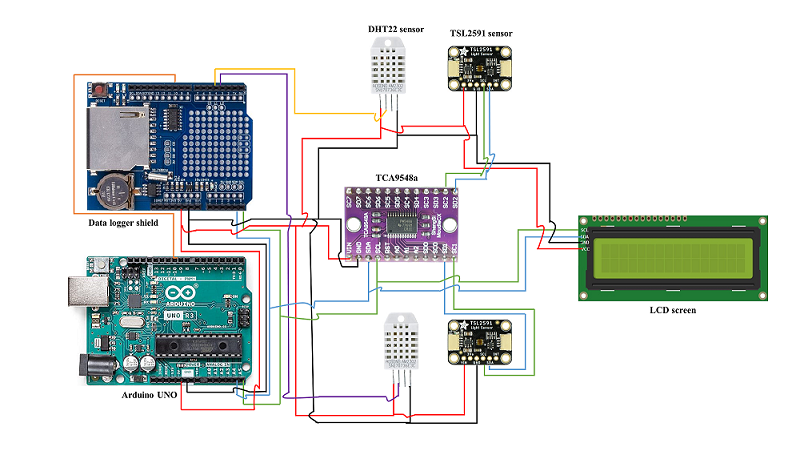low-cost recording-type microcontroller-based temperature, humidity, and light intensity sensor
Monitoring the climate parameters and light intensity inside the greenhouse is as important as observing these parameters outside the greenhouse to maintain proper plant growth and good-quality agricultural products. Generally, these parameters inside the greenhouse depend upon the greenhouse shape, the material used, its size, and ventilation type along with the location and climate conditions. Advanced technologies to monitor these parameters have already been implemented in the greenhouse to ensure good plant yield. However, these instruments are quite expensive and not affordable by small poly house owners. Advancements in information and communication technologies and micro-mechanized sensors allowed the development of low-cost hardware for automation and monitoring in agriculture. Low-cost sensors along with open-source platforms for programming purposes have facilitated the monitoring and control of environmental and crop-related variables in protected environment agriculture. Therefore, we have developed and implemented a microcontroller-based sensor to measure inside and outside climate parameters and light intensity for a naturally ventilated tunnel-type greenhouse.

Arduino uno R3
A microcontroller can be defined as a single-chip special-purpose computer dedicated to performing one specific task in a loop. It consists of memory (RAM, ROM, and flash), input and output pins, and a processor core like a multitasking processor in a computer. However, this microcontroller core is not as fast as in general purpose-computer. In this project, we used the ATmega8535-based microcontroller manufactured by Arduino which is an 8-bit AVR CPU, 8KB flash, 512 Byte EEPROM with 512 Bytes internal SRAM.
Selection of sensor
Temperature and humidity sensor
Integrated temperature and relative humidity (RH) sensors DHT11 and DHT22 were selected for this research work and tested at various field conditions for calibration and validation purposes. Both these sensors DHT11 and DHT22 have three pins for voltage input, a ground pin, and a digital data pin. The temperature and RH range of DHT11 is 0 to 50C and 20 to 80%, respectively while for DHT22 range varies from -40 to 125C and 0 to 100%, respectively. The data sampling rate of DHT11 can be as low as one-second while in the case of DHT22 sampling rate is of two seconds.
Light sensor
To monitor the light intensity inside and outside of the greenhouse two light sensors, Adafruit BH1750 and TSL2591 were selected for evaluation purposes. These sensors were tested at various light intensities and compared with ideal available commercial light sensors for performance evaluation. Both sensors work on the I2C interface and can measure light in terms of lux. The range of the former is 0 to 65,000 lx while the latter can measure light from 0 to 88,000 lx.
Real-time clock and SD card holder
The integrated data logger shield from Adafruit consists of an inbuilt DS1307 real-time clock (RTC) and SD card slot work on FAT16 or FAT32 to store monitored data used during the experiment. This shield comes with a button-type battery to power RTC in case the shield power is cut-off so that time recording will continue. This shield communicates with Arduino either through an inter-integrated circuit (I2C) or serial peripheral interface (SPI).
Liquid crystal display (LCD)
A 16x2 LCD display with an I2C interface was employed to display real-time values of various parameters after a specific time interval along with storing data inside the memory card.
Working
The programming of the microcontroller was accomplished on Arduino integrated development environment (IDE). In this program, instead of the delay function to control time interval, the millis function is adopted which has a number of advantages over the former function. With the help of the latter, virtually we are running two programs simultaneously as different time intervals were selected for displaying parameters on display and storing them in the SD card. As shown in the flow chart, after a particular time, digital signals are sent from the temperature and humidity sensor, and 12C communication from the light sensor to send light luminosity along with a time stamp from RTC, and the data is display on LCD or stored in memory card based on time interval. TCA9548A, which is an I2C multiplexer that allows you to connect multiple I2C devices to a single I2C bus, is used to connect multiple light sensors (TSL2591) as they both have the same I2C address. It acts as a switch and allows one sensor to use the I2C bus at a particular time so as to receive unambiguous data.
Click to view code
